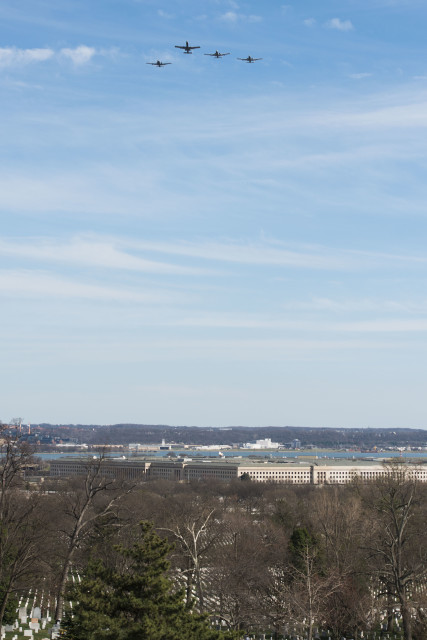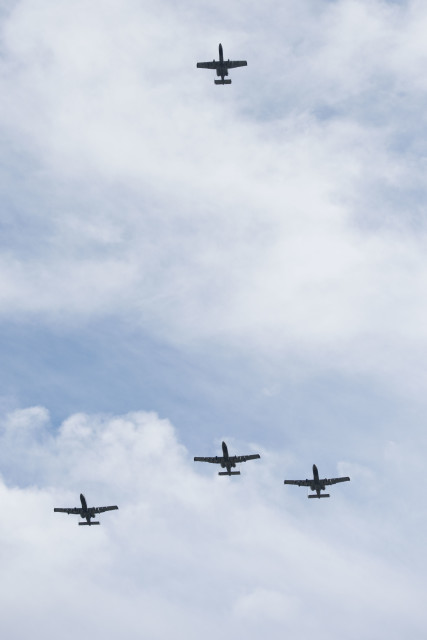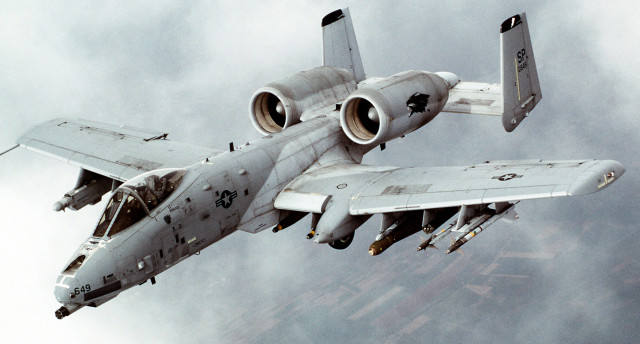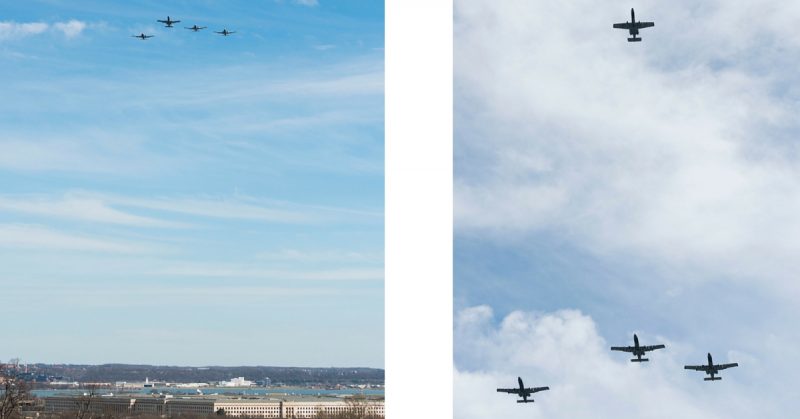A rare flyover occurred at Arlington National Cemetery in March as four A-10s saluted Col. (Ret.) Avery Kay. Kay died on October 29th 2015 and was buried with full military honors.
He was a highly decorated navigator who led some of the most dangerous bombing raids against Germany in World War II. He’s also credited with launching the concept of the A-10 Thunderbolt, aka the Warthog.
The A-10 lacks the air-to-air combat abilities of the F-15 Eagle and the high-tech stealth capabilities of F-22 Raptor, but though it has been over 40 years since its first flight in 1975 the U.S. Air Force still uses the A-10 to support ground forces in combat.
As an adviser to the Air Force Chief of Staff John McConnell in the 1960’s, Kay placed his reputation on the line and led the fight to create a plane designed to assist ground troops.
“Without Col. Kay, there would be no A-10 today,” said Pierre Sprey, a former Pentagon official who helped Kay design the plane despite objections from many in the Air Force leadership.
At that time, the Army and the Air Force hotly debated the division of funding for fixed-wing planes and helicopters.
Army commanders complained that the Air Force took too long to respond to calls for assistance, especially during the Vietnam War. They demanded control of the budget to develop their own heavily armed helicopter that could better meet their needs.
On the other hand, the Air Force wanted control over the development of all fixed-wing aircraft, insisting that any type of plane could perform close air support.
Actually, the Air Force’s top generals had little interest in spending budget money on support for ground troops, preferring planes that could make bombing runs deep in enemy territory.
Kay took charge of the negotiations between the two sides and proposed a plan whereby the Army would give up control of the development of fixed-wing aircraft as long as the Air Force promised to build a plane to provide the air support that was missing in Vietnam.

Using the fact that the Army planned to build a helicopter for ground support, Kay convinced McConnell that if the Army got its funding approved, he would go down in history as the Air Force chief who lost the service its close support mission and the money that goes with it.
Kay countered the Army’s proposal with a plan to build an airplane dedicated to close support missions that would be cheaper and more effective than a helicopter.
McConnell approved the plan, but Kay realized that he would have to go around the normal chain of command to fulfill his promise to the Army. Many of the Air Force’s top generals lacked interest in spending budget to further this cause.
Instead of approaching Air Staff and Tactical command officers, who normally facilitate building new planes, Kay went to Sprey, who was working for the defense secretary, to get the A-10 built.
“What he did at this point is he put his career on the line,” Sprey recalled.
The two worked in secret to develop the aircraft that could cover ground troops, giving the servicemen time to regroup or get out.

“The entire A-10 community is basically due to his guts and his integrity,” said Sprey, now an adviser for the Project on Government Oversight. “If anyone deserves the title of ‘father of the A-10,’ Col. Kay definitely does.”
The A-10 has saved the lives of countless troops during each of the last four wars the U.S. has been involved in. It is in use today against ISIS in Iraq and Syria.
Today, the plane is fighting a similar fight to the one that Kay faced in the 1960’s. It survives year to year because of the strain on Air Force funds as a result of budget sequestration.
The leadership in the Pentagon thinks that the A-10 is too expensive to maintain when other aircraft can fill a similar role. Several lawmakers involved with military allocations believe other expensive undertakings, like finding a way to neutralize the IEDs the U.S. troops face in the Middle East, are higher funding priorities.
The F-35 Lightning is the new, high-tech, massively expensive aircraft set to replace the A-10 to provide close support. Despite the potential, the F-35 has faced numerous setbacks and is still far from ready to deploy.

In January, Gen. David Goldfein, the Air Force’s vice chief of staff, stated that the U.S. air campaign against ISIS is prompting the service to reconsider its plans to retire the A-10.
“When we made the decision on retiring the A-10, we made those decisions prior to ISIL, we were not in Iraq, we were coming out of Afghanistan to a large extent, we didn’t have a resurgent Russia,” Goldfein said in an interview on “Defense News With Vago Muradian.”
The retirement of the A-10 was not part of the Pentagon’s budget request submitted to Congress in February, but the plane’s long-term future remains in doubt.
https://www.youtube.com/watch?v=aFCYDZS_mug
